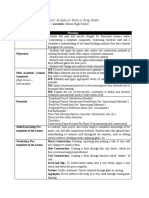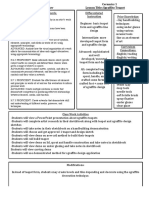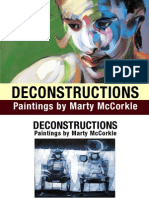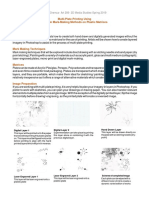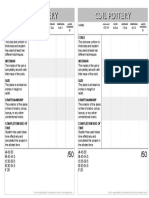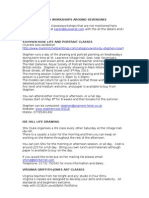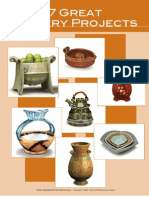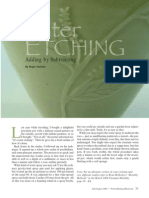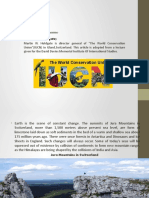Stroke of Genius - Brushes For China Painting
Stroke of Genius - Brushes For China Painting
Uploaded by
Stefan Van CleemputCopyright:
Available Formats
Stroke of Genius - Brushes For China Painting
Stroke of Genius - Brushes For China Painting
Uploaded by
Stefan Van CleemputOriginal Description:
Original Title
Copyright
Available Formats
Share this document
Did you find this document useful?
Is this content inappropriate?
Copyright:
Available Formats
Stroke of Genius - Brushes For China Painting
Stroke of Genius - Brushes For China Painting
Uploaded by
Stefan Van CleemputCopyright:
Available Formats
Brushes for china painting
by Paul Lewing The following article is excerpted from China Paint and Overglaze, by Paul Lewing, published by the American Ceramic Society, Westerville, Ohio, 2007. See review page 44.
lmost any of the supplies for other forms of painting, and many of those for ceramics or printmaking, are useful for china painting. Most novice china painters have had some experience with at least one other form of art, and will have many of the necessary tools already on hand. My brother the musician always says theres nothing to playing the piano; you just hit the right key at the right time. I reply that theres also nothing to drawing; you just make the right mark in the right place. And very often in art, that right mark is best made with a brush. When choosing brushes, remember that the only thing that matters is the finished piece. Your hand and eye determine where the right place is, but the brushes make that right mark, and thus, are your most important tools. Artists brushes are designated as watercolor or oil painting brushes, softer ones generally being for watercolor and stiffer ones for oil. Watercolor brushes generally work well for china painting, particularly if water is used as the medium. Oilbased china paint is a bit thicker and stickier, so many china painters, including myself, prefer a slightly stiffer brush. Size, shape and hair type are the variables that affect the cost and function of a brush.
Shapes
A brushs designation is determined by the shape of its ferrule (the metal or plastic piece that holds bristles to handle) and its end profile. Some common round-ferruled shapes are rounds, liners, riggers, scrollers, scripts and stencils. A good watercolor round is the one indispensable brush. Most china painters prefer them in sizes 4 to 6. The very tiny ones are superfluous if youve got a larger one with a very good point. Liners are long and thin, and riggers (so named because theyre good for drawing the rigging of ships) are longer still. They make long, thin, even lines. The point of a liner may be round or it may be angled, in which case it is called a cut liner. A more exaggerated version of this shape may be made with a flat ferrule and be called a sword liner, specifically designed for banding. Scrollers are slightly thicker in the body, but also have a long thin point. They are used when a line with a small amount of
Brush shapes with round ferrules. Top to bottom: round, liner, scroller, script, cats tongue, cut liner, stencil, deerfoot and whirley.
PotteryMaking Illustrated
March/April 2007
15
variation in width is needed. They similar, but their length and width are also the brush of choice for are the same. Both are used to fill in raised paste and enamel work. broad areas and washes of color, and Scripts are similar to liners, but both are made with either square or with fatter bodies. If only the point angled tips. Flats and brights make is used, they make lines similar to a broad, straight-sided, square-endliners, but if you press down slighted mark when theyre moved up or ly, they will produce a wider line. As down, and a thin mark when moved the name implies, they are used for sideways. Moving them in a circular italic script. motion produces a C-shaped mark. Stencil brushes are flat on the ends, Filberts have a rounded profile and are used to fill stencils with even and make an oval mark. Fitches areas of color. They can also be used taper to a chisel point and make a to remove brush strokes laid down teardrop shape, useful for drawing with another brush, producing a foliage. Fitches and filberts are typistippled pattern. Water-based chically not moved sideways, but only na paint blotted with a dry stencil up and down, although the straight brush will have a finer grain pattern side of a fitch can be used like the than that made with a wet brush. square end of a flat. Very tiny stencil brushes can be Fans also have a flat ferrule, but hard to find, but you can make your the bristles are splayed into a wide own by clipping the end off an old rounded end. They are useful for round. When a stencil brushs end is making streaky marks, and are ofcut at an angle, it is referred to as a ten used dry to blend areas of difdeerfoot stippler. Some brush supferent colors while the paint is still pliers make a variation on the stenwet. Clipping some of the bristles cil brush shape, with shorter, softer can result in very interesting marks. bristles, called a pouncer. Flats and rounds are the most verA cats tongue brush has a thick satile shapes. A selection of these body, and a short, sharp point. A and a good liner or rigger will covflat-ferruled version of this shape er most painting situations. Many is often called a berry brush, and china painters use no more than is specifically designed for painting Brush shapes with flat ferrules. Top to a small round, a liner, and a large many tiny shapes, such as the indi- bottom: flat, bright, filbert, fitch, fan, and small shader, either square or vidual seeds of blackberries. angled. In traditional china paintangled and mop. Mops may be round or flat, but ofing the American style, featuring ten have no ferrule. They hold large quantities of liquid soft naturalistic effects, is usually painted using square and dispense it a little at a time. Mops are also used dry shaders, while the more rigid and brighter Dresden to pick up powdered color when laying a dry ground. style employs more rounds and liners. Most of the above brush shapes are made with either Whirleys (or spooleys) and spatter brushes are unlike metal or quill ferrules. Many china painters prefer quill the above shapes, and are made up of stiff bristles probrushes to metal ferrules because they are more flexible truding from a central shaft. A whirleys bristles are and spring better. Quill brushes also differ from fer- very stiff and short, and are designed to be dragged ruled brushes in that they are not perfectly round, and through a wet stroke to simulate hair. Spatter brushes must be held with the flat side down, or the point will have longer bristles, as well as a piece of wire or wood split or quack into a shape resembling a ducks open along one side. When the brush is rotated against the bill. Many quill brushes are sold without a handle, re- wire, droplets of paint are flung onto the work. quiring the artist to move points from one handle to another, which often splits the quill. They should be soaked in warm water to soften them and pushed genThe best watercolor brushes are Kolinsky sable, retly onto the handle. If they do split, you may slip a nowned for strength, springiness and fine point. Next short piece of heat-shrink tubing over the quill and heat best are red sable, not as springy as Kolinsky, but about it gently with a match. half the price. Sabeline is a fine ox hair dyed to resemThe common flat-ferruled shapes are brights, flats ble sable, and is cheaper but not as good. The cheap(also known as shaders), filberts and fitches. est watercolor brushes are squirrel, sheep, or goat hair. Brights are the most versatile flat-ferruled brushes. Squirrel hair is very fine and limp. They are slightly longer than they are wide. Flats are
Bristles
16
PotteryMaking Illustrated
March/April 2007
Brush strokes made with a round-ferruled brush.
Brush strokes made with a flat-ferruled brush.
The best oil painting brushes are hog bristle and very stiff. Hog bristle brushes are generally too stiff for most china painters taste. A softer oil brush might be mongoose, and an ox hair brush will be softer yet. Camel hair is a trade name applied to any number of hairs, none of which come from camels. The wide variety of synthetic bristles has an enormous range of stiffness, price and holding capacity. It is often difficult to compare brands of brushes, because so many different bristles are simply labeled synthetic. Nylon bristles, which do not taper, are very resilient and easy to clean.
Care
Price
This is a tricky issue for ceramists because biqueware and raw glaze abrade brushes quickly. A fine brush that would last a watercolorist a lifetime may lose its point in a year or two of oxide decoration. China painting is not nearly as hard on brushes, as the smooth glazed surface is not as abrasive. For banding or laying on flat areas of glaze, an expensive brush may be wasted. Sometimes though, only a very good brush will make the mark you need, consistently and repeatedly. With brushes, price is a very good indication of quality, so remember that your brushes are your most important tools. Its often tempting to save a little money by getting the next-best bristles, or a slightly smaller size, but all that matters in making art is what it looks like. Skimping is foolish if the art doesnt look right.
Never dip a dry brush into colors, either water- or oilbased. The brush will not load completely if the bristles are not wetted first. Dip the brush into water or other medium and dry it slightly on a rag. Brushes should be rinsed after use as dried china paint will abrade the bristles. Soap or solvent is not necessary with water-based china paints, but might be with gumfilled commercial products. Oil-based mediums should be rinsed out in clean turpentine or paint thinner. Some china painters also rinse their brushes in alcohol at the end of each session. Avoid strong solvents such as lacquer thinner, shellac remover, or acetone, as they will weaken the glue which holds the hairs in place. If you work with both oil and water mediums, use a separate set of brushes for each. Never rest a brush on its bristles. A brush left to dry that way becomes useless. Brushes which have the bristles glued into the handle, like sumi brushes, should not be left to dry with the tips up. Sumi brushes often have a silk loop on the end of the handle, used to hang the brush point down. Dont let your brushes dry on a heating element or in a blast of hot air. This will dry out the natural oils and make the brush less flexible. Use a palette knife to mix colors, not a brush. I must admit I am consistently guilty of this sin, and my brushes pay the price for it. If you transport your brushes, protect the tips. You can buy a specially made brush case, but a length of
PotteryMaking Illustrated
March/April 2007
17
Paul Lewing, Verses, china paint on porcelain tile, each 12 x 8, 2005. Text was printed full-size, transferred to the tile using graphite paper, and lettered with a #2 script brush.
plastic pipe or even a cardboard box will work as well. I roll mine in a woven bamboo place mat, which allows them to dry, as well as protects them. Specially made brush boxes are available, with springs fixed inside, to hold brushes in place.
back, how the color flows, and how much the brush will hold. Make a comma stroke by moving this dot stroke to the side. Push down, ease up, move the tip and lift up. A good brush will make a clean mark throughout the stroke, with no stray hairs dragging alongside. A C or S stroke is made by moving the brush tip sideways and in a half-circle. A flat-ferruled brush will leave a thick or thin trail according to the angle its traveling. Notice how thin a line you can make when traveling sideways. Test your control of pressure by making this stroke with a round or a liner. If you can maintain an even pressure when changing directions, you will leave a line of even width. You should also be able to make a line of even width with a flat or bright, using a straight stroke. This is the stroke you will use most often, to fill in areas of color. Its most often made by pulling the brush toward yourself, but practice making it in all directions. Try using more than one color on your brush. To load a round brush with two colors, fill it normally, blot off the tip, and load the tip with a contrasting color. Using a flat brush, load each side with a differ-
Testing Brushes
Evaluating brushes is very difficult, but some art supply stores will provide plain water and paper. New brushes often have a protective plastic sleeve over the bristles. If you remove this, be very careful if you put it back on, as its easy to bend a few hairs back and damage them. Sharp-pointed brushes usually have a stiff sizing in them to protect the point. Soak this out in water before testing them. Drop a dry, unsized brush on its tip to assess springiness. Wet it and see if it comes to a point naturally. Make strokes up, down and in a circle, to see the differences in the mark. Push the brush straight down to see what mark that makes. Vary the pressure from light to hard to light again, to see if the point returns. Keep doing this until the brush is dry to test its capacity.
Brush Strokes
Paul Lewing, Psalm 121:1,2, 40 x 52. First Presbyterian Church, Seattle, WA. Lettering done with a #8 bright.
A brushs size, shape and type of bristle all contribute to the mark it will produce, but the art is in the stroke. While there are an infinite variety of combinations and permutations, all brush marks are the result of a few basic motions. Try all these motions with every one of your brushes. Try them with the brush well loaded, and almost empty. Use a very fluid medium and a sticky one, on both vertical and horizontal surfaces. Notice how a soft or a stiff brush, or a short or long handle, feels. Just lightly touch the surface, and continue to press until the ferrule touches the work. The easiest stroke might be called a pecking stroke. Just touch a loaded brush tip straight down on the surface. A flat brush produces a line; a round one, a dot. Notice how clean or frayed the mark is. Continue this until the brush is empty, noting how well the tip springs
ent color. For an even gradation, mix the two colors next to each other on a palette, and drag the brush back and forth between them until they blend. Now practice all the above strokes. An interesting practice exercise is to load two colors on a flat or bright, and make a straight stroke in which you vary the pressure on one edge, but not the other. This produces a mark that is straight on one side and wavy on the other. Interesting leaves and vegetation can be depicted this way. Flip the brush over and draw the other side of the leaf, to shade on the opposite side.
Paul Lewing is the author of China Paint and Overglaze, and has been a professional clay artist since 1972. For comments, contact Paul at pjlewing@comcast.net.
18
PotteryMaking Illustrated
March/April 2007
You might also like
- Self Reliant Potter GLAZES You Can MakeDocument162 pagesSelf Reliant Potter GLAZES You Can MakeStefan Van Cleemput100% (3)
- Mason High - Ceramics 2 - Centerpiece Lesson PlanDocument4 pagesMason High - Ceramics 2 - Centerpiece Lesson Planapi-267189611No ratings yet
- Color Mixing For Artists - Constance SayasDocument2 pagesColor Mixing For Artists - Constance SayasMervi Hjelmroos-KoskiNo ratings yet
- 7 Layers Technique PDFDocument5 pages7 Layers Technique PDFMilanRoguljaNo ratings yet
- Getting Handle On CaneDocument5 pagesGetting Handle On CaneStefan Van Cleemput100% (2)
- Gas Kiln Design & FiringDocument10 pagesGas Kiln Design & FiringStefan Van Cleemput100% (2)
- StarbucksDocument3 pagesStarbucksMudit SinghNo ratings yet
- DSW Part2Document37 pagesDSW Part2miller999No ratings yet
- Varnishing Oil PaintingsDocument1 pageVarnishing Oil Paintingsdorut100% (1)
- Seven Layer PaintingDocument4 pagesSeven Layer PaintingEnrique EscognitoNo ratings yet
- Oil Paint: Oil Paint Is A Type of Slow-Drying Paint That ConsistsDocument5 pagesOil Paint: Oil Paint Is A Type of Slow-Drying Paint That Consistssagar pajankarNo ratings yet
- Subtractive SculptureDocument21 pagesSubtractive Sculptureapi-244403268No ratings yet
- Ceramics I - Final Project Lesson PlanDocument4 pagesCeramics I - Final Project Lesson Planapi-267189611No ratings yet
- Material List For Oil PaintingDocument1 pageMaterial List For Oil PaintingsavageNo ratings yet
- BotanyDocument2 pagesBotanyMervi Hjelmroos-KoskiNo ratings yet
- Airbrush User ManualDocument2 pagesAirbrush User ManualStefan PetcuNo ratings yet
- Sgraffito Teapot Hs Ceramics 1Document1 pageSgraffito Teapot Hs Ceramics 1api-268225079No ratings yet
- French Polishing 1Document2 pagesFrench Polishing 1tfahrenkNo ratings yet
- Crveno Grozdje - Slikanje Flamanskom TehnikomDocument29 pagesCrveno Grozdje - Slikanje Flamanskom TehnikomDejan TrajkovićNo ratings yet
- History Egg TemperaDocument4 pagesHistory Egg TemperaAuk van HiltenNo ratings yet
- ARTPAPA GreenappleDocument3 pagesARTPAPA GreenappleIldiko KarsayNo ratings yet
- Alvaro Castagnet 2011Document2 pagesAlvaro Castagnet 2011Angela BarbiNo ratings yet
- Deconstructions: Paintings by Marty MccorkleDocument23 pagesDeconstructions: Paintings by Marty Mccorklemarty_mccorkleNo ratings yet
- Silk Screen Color Printing - Presenting a New Addition to the Graphic Arts-Serigraphy - A Demonstration and Explanation of the Process of Making 'Multiple Original' Color PrintsFrom EverandSilk Screen Color Printing - Presenting a New Addition to the Graphic Arts-Serigraphy - A Demonstration and Explanation of the Process of Making 'Multiple Original' Color PrintsNo ratings yet
- Multiplate DemoDocument5 pagesMultiplate Demoapi-444451473No ratings yet
- Egg TemperaDocument6 pagesEgg TemperaVignesh EnNo ratings yet
- Betty WoodmanDocument22 pagesBetty WoodmanMargaret MillerNo ratings yet
- Sculpture Sketchbook PromptsDocument2 pagesSculpture Sketchbook Promptsapi-260853196No ratings yet
- The Art of Painting in Oil and in Fresco Being A History Mérimée JFL 1757 1836.Document429 pagesThe Art of Painting in Oil and in Fresco Being A History Mérimée JFL 1757 1836.Andréa TeixeiraNo ratings yet
- NFU Crystalline GlazeDocument18 pagesNFU Crystalline GlazemarcelodalboNo ratings yet
- Mosaic Tech VitralDocument8 pagesMosaic Tech Vitraljoman1953100% (1)
- Ceramic SpectrumDocument5 pagesCeramic SpectrumMaria Auxiliadora RodriguezNo ratings yet
- Mezzo TintDocument4 pagesMezzo TintPaula ZorziNo ratings yet
- Methods and Materials1997Document64 pagesMethods and Materials1997Ekaterina MeshalkinaNo ratings yet
- 3 Ways To Make Your Own Glazing Medium For Oil Painting - WikiHowDocument23 pages3 Ways To Make Your Own Glazing Medium For Oil Painting - WikiHowetsipoulesobabikosNo ratings yet
- Rye1976 Temper PotteryDocument34 pagesRye1976 Temper PotteryROGNo ratings yet
- Color in ArtDocument11 pagesColor in ArtAnthony TanNo ratings yet
- Roman CupDocument8 pagesRoman CupJiri Van denNo ratings yet
- GEC 06. PaintingDocument37 pagesGEC 06. PaintingErica BalibadoNo ratings yet
- Stained Glass Windows and MosaicsDocument10 pagesStained Glass Windows and MosaicsAneesh MalhotraNo ratings yet
- Create PastelsDocument10 pagesCreate PastelsREVE EPOQUENo ratings yet
- ... - Oil Painting Without SolventsDocument2 pages... - Oil Painting Without Solventsdorut50% (2)
- Chevreuls Law F1 Web GoodDocument28 pagesChevreuls Law F1 Web Goodsiege@telkom.netNo ratings yet
- Coil Pottery RubricDocument1 pageCoil Pottery Rubricapi-353132074No ratings yet
- Intro. To PaintingDocument46 pagesIntro. To PaintingIanMonisNo ratings yet
- Marbling - Tricks of The Trade Learned Over 20 YearsDocument21 pagesMarbling - Tricks of The Trade Learned Over 20 YearscyberkikeNo ratings yet
- Ceramics DefinitionsDocument2 pagesCeramics DefinitionsNiranjanNo ratings yet
- Oil Painting Powerpoint WorksheetDocument2 pagesOil Painting Powerpoint Worksheetapi-293964578No ratings yet
- 0 York Dec15cmDocument4 pages0 York Dec15cmapi-24483605No ratings yet
- Robert Howard - MediumsDocument2 pagesRobert Howard - MediumsdorutNo ratings yet
- Colour Charts AssignmentDocument3 pagesColour Charts AssignmentNESLİHAN ORALNo ratings yet
- Relief PrintDocument2 pagesRelief PrintRjvm Net Ca FeNo ratings yet
- Art 000700-0092 Boonyaporn ProcessportfolioDocument24 pagesArt 000700-0092 Boonyaporn Processportfolioapi-254774586No ratings yet
- TH THDocument16 pagesTH THapi-347222540No ratings yet
- Ib2 2017-18 CalendarDocument4 pagesIb2 2017-18 Calendarapi-291759842No ratings yet
- Art Classes by KarenDocument5 pagesArt Classes by KarenDoron ArtNo ratings yet
- Expressive Self Portrait Clay Bust Project DescriptionDocument6 pagesExpressive Self Portrait Clay Bust Project Descriptionapi-233396734No ratings yet
- Flemish Technique Forum 1Document80 pagesFlemish Technique Forum 1Pintar En ÓleoNo ratings yet
- Art 10 Ceramic UnitDocument4 pagesArt 10 Ceramic Unitapi-336053232No ratings yet
- Paul Demarrais Pastels: Mixing It UpDocument7 pagesPaul Demarrais Pastels: Mixing It Upmarimarsilva072014No ratings yet
- Grisaille HandoutDocument5 pagesGrisaille Handoutandrewsrobert540No ratings yet
- Origin and Development of Form and Ornament in Ceramic ArtFrom EverandOrigin and Development of Form and Ornament in Ceramic ArtNo ratings yet
- 10 Raku Glaze RecipesDocument7 pages10 Raku Glaze Recipesthanhthanhtrade100% (1)
- Tour de France 2015 RoadbookDocument232 pagesTour de France 2015 RoadbookStefan Van CleemputNo ratings yet
- 7 Great Pottery ProjectsDocument26 pages7 Great Pottery Projectsapi-26965779100% (8)
- Great Throwing TechniquesDocument12 pagesGreat Throwing Techniquescloverthanh100% (1)
- 33 Tried True Glaze RecipesDocument22 pages33 Tried True Glaze Recipesthanhthanhtrade100% (8)
- Raku With Lusters - John MartinDocument4 pagesRaku With Lusters - John MartinStefan Van Cleemput100% (1)
- Barrel Firing - Paul WandlessDocument9 pagesBarrel Firing - Paul WandlessStefan Van Cleemput0% (1)
- Staying TrimDocument4 pagesStaying TrimStefan Van CleemputNo ratings yet
- Steven BranfManDocument5 pagesSteven BranfManStefan Van CleemputNo ratings yet
- Electric Kiln Firing TechDocument13 pagesElectric Kiln Firing TechStefan Van CleemputNo ratings yet
- Pressing Matters: Making Platters With MoldsDocument5 pagesPressing Matters: Making Platters With MoldsStefan Van Cleemput100% (1)
- Large Pots - Bill ShinnDocument4 pagesLarge Pots - Bill ShinnStefan Van Cleemput100% (2)
- Fired Up - JF08Document1 pageFired Up - JF08Stefan Van CleemputNo ratings yet
- Glazing PatternsDocument4 pagesGlazing PatternsStefan Van CleemputNo ratings yet
- Roger GrahamDocument3 pagesRoger GrahamStefan Van CleemputNo ratings yet
- Winter Wisteria: Home-Grown HandlesDocument4 pagesWinter Wisteria: Home-Grown HandlesStefan Van CleemputNo ratings yet
- From Slab To GrabDocument4 pagesFrom Slab To GrabStefan Van CleemputNo ratings yet
- Barbara Van SickleDocument4 pagesBarbara Van SickleStefan Van CleemputNo ratings yet
- Raku - James FisherDocument3 pagesRaku - James FisherStefan Van Cleemput100% (1)
- 00 Tips From ProsDocument11 pages00 Tips From ProsStefan Van CleemputNo ratings yet
- Jake Allee ND07Document4 pagesJake Allee ND07Stefan Van CleemputNo ratings yet
- Planetary Just Transition - How Inclusive and How JustDocument11 pagesPlanetary Just Transition - How Inclusive and How JustpricillyaNo ratings yet
- Finding Winnie Educator GuideDocument11 pagesFinding Winnie Educator GuideLittle, Brown Books for Young Readers75% (4)
- Dams My PPT (Autosaved) .PpsDocument74 pagesDams My PPT (Autosaved) .Ppssefok90385No ratings yet
- 15 Zanzibar-Declaration PDFDocument7 pages15 Zanzibar-Declaration PDFmomo177sasaNo ratings yet
- The Jehovah's Witnesses New Headquarters in Warwick - Archaeological InvestigationDocument66 pagesThe Jehovah's Witnesses New Headquarters in Warwick - Archaeological InvestigationsirjsslutNo ratings yet
- Pembuatan Tisu Dari Pelepah Pisang, Serbuk Kayu Dan Daun KeringDocument3 pagesPembuatan Tisu Dari Pelepah Pisang, Serbuk Kayu Dan Daun KeringAdinda Annisa KhurinNo ratings yet
- Shark and RayDocument16 pagesShark and RayQueen RoyNo ratings yet
- Stevens, P. (2012) Towards An Ecosociology - Sociology 46 - 4 PDFDocument17 pagesStevens, P. (2012) Towards An Ecosociology - Sociology 46 - 4 PDFPaul StevensNo ratings yet
- NCERT-Contemporary India II - Class XDocument99 pagesNCERT-Contemporary India II - Class Xnikhilam.com67% (3)
- Importance of Environmental Care by Laurence NdlovuDocument6 pagesImportance of Environmental Care by Laurence Ndlovuvibesjust826No ratings yet
- The Dodo Bird: A Symbol of ExtinctionDocument3 pagesThe Dodo Bird: A Symbol of ExtinctionKizha2528No ratings yet
- Resource Booklet: Environmental Systems and Societies Standard Level Paper 1Document13 pagesResource Booklet: Environmental Systems and Societies Standard Level Paper 1Mariam KhalilNo ratings yet
- ESE150-2 M3Exam VillaramaDocument2 pagesESE150-2 M3Exam VillaramaThortheGreayNo ratings yet
- CVRD Regional Services Committee Packet - 20191023Document344 pagesCVRD Regional Services Committee Packet - 20191023Chris CrowtherNo ratings yet
- Agora Athenei, Opaitele GrecestiDocument321 pagesAgora Athenei, Opaitele GrecestiSteftyraNo ratings yet
- Principles and Standards - SERDocument46 pagesPrinciples and Standards - SERMarco AcevedoNo ratings yet
- Ipcc wg3 Ar5 Final-Draft Postplenary Chapter4 PDFDocument116 pagesIpcc wg3 Ar5 Final-Draft Postplenary Chapter4 PDFAndres Alejandro CamargoNo ratings yet
- Agroecology Policy Formulation Paper 2023Document1 pageAgroecology Policy Formulation Paper 2023Sumarni LamanNo ratings yet
- Article Review FormDocument2 pagesArticle Review FormdinarsyifaNo ratings yet
- Health Impact Assessment of Greenspace: A GuideDocument82 pagesHealth Impact Assessment of Greenspace: A GuideSalim Vohra100% (1)
- Learning Activities 7Document2 pagesLearning Activities 7Rain Storm Polgadera100% (1)
- Inventor and Invention Pasive Voice 1Document2 pagesInventor and Invention Pasive Voice 1Claudia Ortiz VicenteNo ratings yet
- Group 2 DanubeDeltaBiosphereReserveDocument19 pagesGroup 2 DanubeDeltaBiosphereReserveMirza Ahmer BAIGNo ratings yet
- BIOMUSEODocument5 pagesBIOMUSEORover DmsNo ratings yet
- Food ChainsDocument5 pagesFood ChainsAishath NashwaNo ratings yet
- Life: Plants: Ben Joshua R. Mancile December 13, 2021 BS Human Biology Botafun N04Document2 pagesLife: Plants: Ben Joshua R. Mancile December 13, 2021 BS Human Biology Botafun N04Ben Joshua MancileNo ratings yet
- CLUSTER VII October 2019 To March 2020Document427 pagesCLUSTER VII October 2019 To March 2020ShrutiNo ratings yet
- Hubco ClassDocument26 pagesHubco ClassMuhammad Hassan Rasheed Ul HassanNo ratings yet
- The Environment of Tomorrow (Part I)Document15 pagesThe Environment of Tomorrow (Part I)Danilo de Leon100% (1)












